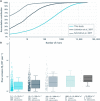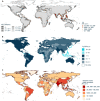More than 1000 rivers account for 80% of global riverine plastic emissions into the ocean
- PMID: 33931460
- PMCID: PMC8087412
- DOI: 10.1126/sciadv.aaz5803
More than 1000 rivers account for 80% of global riverine plastic emissions into the ocean
Abstract
Plastic waste increasingly accumulates in the marine environment, but data on the distribution and quantification of riverine sources required for development of effective mitigation are limited. Our model approach includes geographically distributed data on plastic waste, land use, wind, precipitation, and rivers and calculates the probability for plastic waste to reach a river and subsequently the ocean. This probabilistic approach highlights regions that are likely to emit plastic into the ocean. We calibrated our model using recent field observations and show that emissions are distributed over more rivers than previously thought by up to two orders of magnitude. We estimate that more than 1000 rivers account for 80% of global annual emissions, which range between 0.8 million and 2.7 million metric tons per year, with small urban rivers among the most polluting. These high-resolution data allow for the focused development of mitigation strategies and technologies to reduce riverine plastic emissions.
Copyright © 2021 The Authors, some rights reserved; exclusive licensee American Association for the Advancement of Science. No claim to original U.S. Government Works. Distributed under a Creative Commons Attribution NonCommercial License 4.0 (CC BY-NC).
Figures





References
-
- Rochman C. M., Browne M. A., Halpern B. S., Hentschel B. T., Hoh E., Karapanagioti H. K., Rios-Mendoza L. M., Takada H., Teh S., Thompson R. C., Policy: Classify plastic waste as hazardous. Nature 494, 169–171 (2013). - PubMed
-
- Lebreton L., Slat B., Ferrari F., Sainte-Rose B., Aitken J., Marthouse R., Hajbane S., Cunsolo S., Schwarz A., Levivier A., Noble K., Debeljak P., Maral H., Schoeneich-Argent R., Brambini R., Reisser J., Evidence that the Great Pacific Garbage Patch is rapidly accumulating plastic. Sci. Rep. 8, 4666 (2018). - PMC - PubMed
LinkOut - more resources
Full Text Sources

